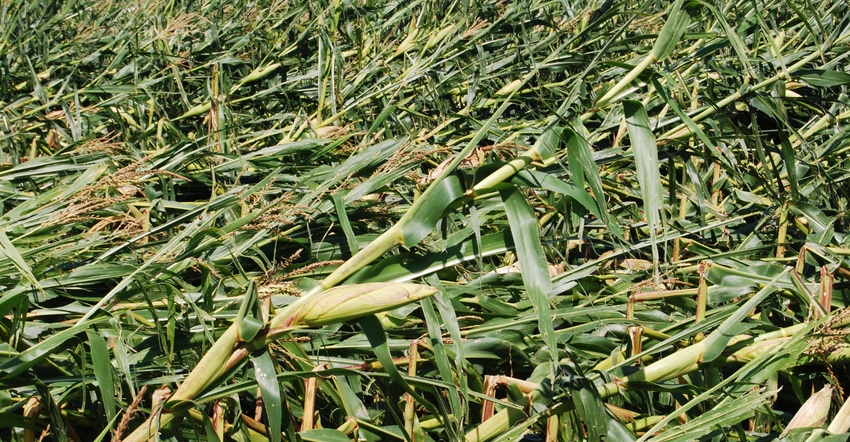August 21, 2020

Can farmers collect crop insurance and harvest their wind-damaged corn crop as silage? That’s a question many farmers in Iowa are asking, as a result of the derecho windstorm on Aug. 10 that tore across central and eastern Iowa. It left many cornfields with leaning, flattened, broken and tangled stalks heading into harvest.
Corn quality and whether all acres need to be harvested are other common questions farmers are asking about. To answer those questions and others, USDA’s Risk Management Agency has updated it’s Frequently Ask Questions page on the RMA website. RMA writes the rules and oversees the companies providing crop insurance, which are referred to as approved insurance providers, or AIPs.
Duane Voy, director of the RMA regional office for Iowa, Minnesota and Wisconsin, says RMA updated the FAQs on Aug. 19 and suggests farmers and insurance agents refer to its website for the latest guidelines.
Derecho adds complications
Crop insurance rules for qualifying and collecting claims can be confusing, and the derecho damage situation varies from field to field, which further adds complications. But the FAQs and answers on the website are helpful. For example, here’s the answer to this often-asked question:
If my wind-damaged cornfield has been appraised and is released by the AIP, am I allowed to attempt to salvage any remaining crop for use as silage? Yes, but there are differences based on how the corn is insured (corn for grain or corn for silage):
Corn insured for silage. If a producer agrees to settle based on appraised production but still attempts to harvest for silage, the producer must accept the higher of the appraised or harvested production for claims purposes.
Corn insured for grain. If a producer agrees to settle based on appraised production and the AIP releases for another use, and the producer then attempts to harvest for silage, there are no impacts and the producer is not required to take the higher of appraised or harvested production. However, if the producer attempts to harvest as grain, the higher of the appraised or actual harvested production will be used for claims purposes.
Concerns about grain quality
Another concern expressed by farmers and grain elevator managers is that if corn is left in the field until harvest, it will develop mold and toxins and not improve its quality. When the derecho struck the fields, corn was still maturing, and the average test weight was only about 40 pounds or so. Elevators will struggle to receive low-test weight new crop corn. Harvestability of the flattened and tangled cornfields will be nasty to say the least.
ISU Extension grain quality specialist Charlie Hurburgh says test weight of this corn in many cases, if left in the field to, hopefully, mature, will be less than the standard 56 pounds per bushel for No. 2 yellow corn. He says the test weight even if the corn matures slowly will likely be around 45 to 50 pounds per bushel — some less, some more. It will have very poor storability and a high likelihood of mold development on the ears if plants are laying on the ground. That increases risk of mycotoxins developing in the grain.
He says the consensus of ISU agronomists is most of the corn plants damaged or destroyed by the windstorm had reached approximately 50% in terms of reaching their potential final dry matter content. Plants that are leaning badly in fields will probably straighten up at least a little, but fields that are completely flat won’t recover much if at all. Some plants may remain alive and continue to mature slowly, others may not.
Helpful resources available
The crops team with ISU Extension is offering timely information on storm damage and cleanup. Follow the Integrated Crop Management web page for additional updates and for storm-related news releases follow ISU Extension and Outreach news. Current resources include information on:
how to assess the extent of crop damage and what farmers can reasonably expect going forward.
how to inspect wind-damaged grain bins and make decisions on whether to repair or replace.
whether corn that was intended for grain can be harvested for silage and the harvest and storage considerations required.
metal health and suicide prevention through Iowa Concern.
The list is being updated as cleanup continues and as specialists continue to assess the immediate and long-term impacts of the storm. The derecho that swept across Iowa Aug. 10 caused damage that will plague Iowans this fall and possibly into the new year.
About 14 million acres of insured crops were affected, according to the Iowa Department of Agriculture. That includes 8.2 million acres of corn and 5.6 million acres of soybeans, spread across 57 Iowa counties.
You May Also Like




